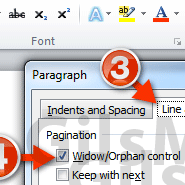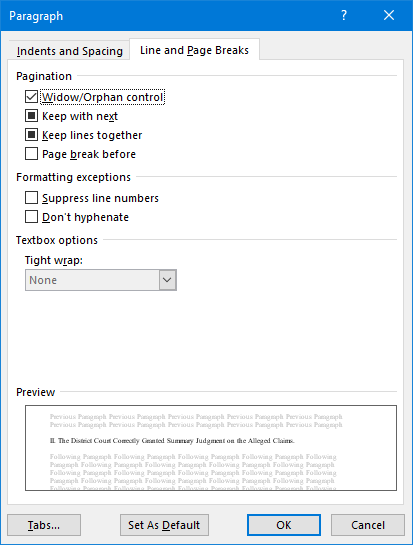
In Office 2011 for Mac, this kind of tab stop is the left tab stop. These days, tabs do a lot more than just act as a position to stop the cursor. Tabs work at the paragraph level; when you set tab stops, they work with the currently selected paragraphs. Word 2011 includes support for Microsoft SharePoint, SkyDrive, simultaneous document editing, the option to communicate with others while you edit documents together, and improves the control you. Sep 18, 2014 I have MS office 2011 SP1 home & Business for MAC OS 10.5.8. Is this will install on my MAC OS 10.6.8? If yes than why on it written Mac OS 10.5.8. Regards, Samir The. Apr 26, 2019 1) Move your cursor to the paragraph in your document that is split with widow or orphan lines. 2) Click Format Paragraph from the menu bar. 3) Click Line and Page Breaks at the top. 4) Directly below that, under Pagination, check the box for Widow/Orphan control. Microsoft has been readying its latest update to Office for Mac, and recently released its first preview. We decided to give it a whirl and wanted uninstall Office 2011 to avoid any conflicts. Much to our surprise, uninstalling Office 2011 for Mac is a terribly complicated affair. Select the paragraphs in which you want to control widows and orphans. On the Home tab in Word, or on the FORMAT TEXT tab in an Outlook email, select the Paragraph Dialog Box launcher. Select the Line and Page Breaks tab.
If you think widows and orphans in your Word document are distracting, How to Stop Pages from Breaking After the First Line of a Paragraph in Microsoft Word. Control widows and orphans easily. To limit widows and orphans in your whole document, I wrote something on my blog about widows and orphans a few months.
At the end of the first paragraph, the word 'lorem' is an orphan in the second sense: a very short final line that, because the rest of its line is white, creates an impression of two lines of whitespace between the paragraphs.
In typesetting, widows and orphans are lines at the beginning or end of a paragraph which are left dangling at the top or bottom of a page or column, separated from the rest of the paragraph. (The typographer's terms for the top and bottom of a page or column are head and foot.)
Definitions[edit]
There is some disagreement about the definitions of widow and orphan; what one source calls a widow another calls an orphan.[1][full citation needed][2][3][dead link]The Chicago Manual of Style provides these definitions:[3][dead link]
- Widow
- A paragraph-ending line that falls at the beginning of the following page or column, thus separated from the rest of the text. Mnemonically, a widow is 'alone at the top' (albeit of the family tree but, in this case, of the page).
- Orphan
- A paragraph-opening line that appears by itself at the bottom of a page or column, thus separated from the rest of the text. Mnemonically, an orphan is 'alone at the bottom' (albeit of the family tree but, in this case, of the page).
- Alternately, A word, part of a word, or very short line that appears by itself at the end of a paragraph. Mnemonically still 'alone at the bottom', just this time at the bottom of a paragraph. Orphans of this type give the impression of too much white space between paragraphs.
Remembering the terms[edit]
A common mnemonic is 'An orphan has no past; a widow has no future'[4] or 'An orphan is left behind, whereas a widow must go on alone'.
Another way to think is that orphaned lines appear at the 'birth' (start) of paragraphs; widowed lines appear at the 'death' (end) of paragraphs. 'An orphan is alone from the beginning; a widow is alone at the end,' or 'An orphan starts alone, a widow ends alone.'
Guidelines[edit]
Writing guides, such as the Chicago Manual of Style, generally suggest that a manuscript should have no widows and orphans even if the result of avoiding them is additional space at the bottom of a page or column.[5] However, in its 16th edition (2011) the Chicago Manual of Style suggests a new convention in which pages may end with the first line of a new paragraph.[6]

Some techniques for eliminating widows include:
- Forcing a page break early, producing a shorter page;
- Adjusting the leading, the space between lines of text (although such carding or feathering is usually frowned upon);
- Adjusting the spacing between words to produce 'tighter' or 'looser' paragraphs;
- Adjusting the hyphenation within the paragraph;
- Adjusting the page's margins;
- Subtle scaling of the page, though too much non-uniform scaling can visibly distort the letters;
- Rewriting a portion of the paragraph;
- Reduce the tracking of the words;
- Adding a pull quote to the text (more common for magazines); and
- Adding a figure to the text, or resizing an existing figure.
An orphan is cured more easily, by inserting a blank line or forcing a page break to push the orphan line onto the next page to be with the rest of its paragraph. Such a cure may have to be undone if editing the text repositions the automatic page or column break.
Similarly, a single orphaned word at the end of a paragraph can be cured by forcing one or more words from the preceding line into the orphan's line. In web-publishing, this is typically accomplished by concatenating the words in question with a non-breaking space and, if available, by utilizing the orphans: and widows: attributes in Cascading Style Sheets. Sometimes it can also be useful to add non-breaking spaces to the first two (or few) short words of a paragraph to avoid that a single orphaned word is placed to the left or right of a picture or table, while the remainder of the text (with longer words) would only appear after the table.
Most full-featured word processors and page layout applications include a paragraph setting (or option) to automatically prevent widows and orphans. When the option is turned on, an orphan is forced to the top of the next page or column; and the line preceding a widow is forced to the next page or column with the last line.
In technical writing where a single source may be published in multiple formats, and now in HTML5 with the expectation of viewing content at different sizes or resolutions, it is recommended[according to whom?] to use the word processor settings that automatically prevent widows and orphans. Manual overrides such as inserted empty lines or extra spaces can cause unexpected white space in the middle of pages.
References[edit]
- ^Carter, Rob. A widowed line, highlighted in yellow.
- ^Day, Ben. Meggs, Philip. Typographic Design: Form and Communication. 2nd ed. John Wiley & Sons: 1993. p. 263.
- ^ abChicago Manual of Style.
- ^Bringhurst, Robert. The Elements of Typographic Style. 3rd ed. Hartley and Marks Publishers: 2004. pp. 43–44 ISBN0-88179-206-3
- ^Chicago Manual of Style, 15th Edition, 3.11 Overall appearance: 'A page should not begin with the last line of a paragraph unless it is full measure and should not end with the first line of a new paragraph.'
- ^Chicago Manual of Style, 16th Edition, 2.113: 'A page should not begin with the last line of a paragraph unless it is full measure. (A page can, however, end with the first line of a new paragraph.)'
Widows And Orphans Microsoft Word
If your power goes out or your computer malfunctions when working on an Word for Mac 2011 document, all you have to do is open the application again. Word 2011 for Mac looks for and opens any AutoRecover files for the document(s) that you were working on when an unexpected crash occurred. Your document opens with “Recovered” appended to the filename. Choose File→Save As from the menu bar to restore the original filename and location.

Word for Mac can recover files that were open because, by default, Word autosaves your document every ten minutes while you’re working on it. If you want, you can change the save time interval within the AutoRecover setting as follows:
Choose Word→Preferences→Save from the menu bar.
Word’s Save preferences are displayed.
Change the number of minutes in the Save AutoRecover Info Every: [X] Minutes setting.
The default is 10 minutes. Entering a lower number saves more often, but you may notice Word is more sluggish when it saves so often. Entering a higher number may make Word perform better, but you may lose more changes if a power outage or computer crash occurs.
You can deselect this check box if you don’t want Word to save an AutoRecover file. You might do this for extremely large documents that take a long time to save. Of course, if you experience a power outage or computer crash, you will lose all your changes since the last time you manually saved the file.
You don’t need to select the Always Create Backup Copy check box. With AutoRecover and Time Machine, the bases are covered. The option is there only for backward compatibility.
Click OK when you’re finished.
Microsoft Word For Mac Free
Rarely, Word might not automatically display the AutoRecover file for the document(s) you were working on the next time you open Word. In that case, do the following in Word to open the AutoRecover file:
Choose File→Open from the menu bar.
Type AutoRecover or type a keyword or phrase in the Spotlight Search box in the top-right corner of the Open dialog.
Double-click the most recently saved AutoRecover file, or select the file and click Open. If you did a keyword or phrase search, use the Last Opened information to help you choose a likely file to open.
If the file you want is grayed-out, choose All Files in the Enable pop-up menu, which allows you to open any file type.
Microsoft Word 2011 Mac Orphan Control Word
You can also use Mac OS X Time Machine to recover any file that you’ve saved at least once. When you use Word for Mac, it’s nearly impossible to lose more than a few minutes’ worth of work thanks to AutoRecover and Time Machine.